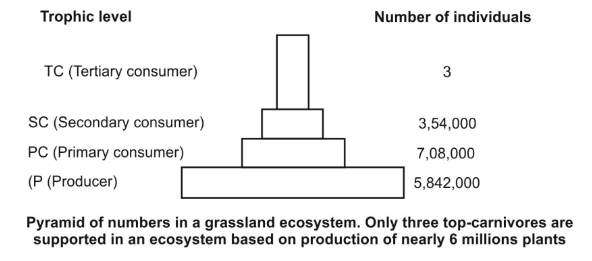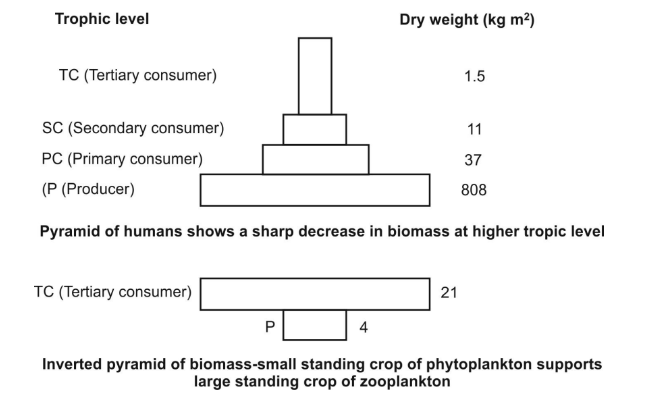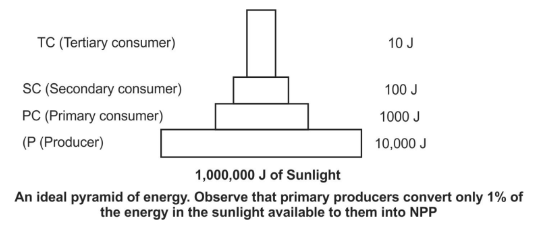- The base of a pyramid is broad and it narrows towards the apex. One gets a similar shape, whether you express the food or energy relationship between organisms at different trophic levels. This, relationship is expressed in terms of number, biomass or energy. The base of each pyramid represents the producers or the first trophic level while the apex represents tertiary or top level consumer. The three types of ecological pyramids that are usually studied are (a) pyramid of number; (b) pyramid of biomass and (c) pyramid of energy.
a.Pyramid of number: This represents the number of organisms at each trophic level. For example in a grassland the number of grasses is more than the number of herbivores that feed on them and the number of herbivores is more than the number of carnivores. In some instances the pyramid of number may be inverted, i.e herbivores are more than primary producers as you may observe that many caterpillars and insects feed on a single tree.

b.Pyramid of biomass: This represents the total standing crop biomass at each trophic level. Standing crop biomass is the amount of the living matter at any given time. It is expressed as gm/unit area or kilo cal/unit area. In most of the terrestrial ecosystems the pyramid of biomass is upright. However, in case of aquatic ecosystems the pyramid of biomass may be inverted e.g. in a pond phytoplankton are the main producers, they have very short life cycles and a rapid turnover rate (i.e. they are rapidly replaced by new plants). Therefore, their total biomass at any given time is less than the biomass of herbivores supported by them.

c.Pyramid of energy: This pyramid represents the total amount of energy at each trophic level. Energy is expressed in terms of rate such as kcal/unit area /unit time or cal/unit area/unit time. Energy pyramids are never inverted.

- Any calculations of energy content, biomass or numbers, has to include all organisms at that trophic level. No generalisations we make will be true if we take only a few individuals at any trophic level into account. Also a given organism may occupy more than one trophic level simultaneously. The trophic level represents a functional level, not a species as such. A given species may occupy more than one trophic level in the same ecosystem at the same time; for example, a sparrow is a primary consumer when it eats seeds, fruits, peas, and a secondary consumer when it eats insects and worms.
- In most ecosystems, all the pyramids, of number, of energy and biomass are upright, i.e., producers are more in number and biomass than the herbivores, and herbivores are more in number and biomass than the carnivores. Also energy at a lower trophic level is always more than at a higher level.
|
Note:
|
Limitations of Ecological Pyramids
- It does not take into account the same species belonging to two or more trophic levels. It assumes a simple food chain, something that almost never exists in nature; it does not accommodate a food web.
- Saprophytes are not given any place in ecological pyramids even though they play a vital role in the ecosystem.
Population Interactions
- Interspecific interactions arise from the interaction of populations of two different species. They could be beneficial, detrimental or neutral (neither harm nor benefit) to one of the species or both. Assigning a ‘+’ sign for beneficial interaction, ‘-’ sign for detrimental and 0 for neutral interaction.
Population Interactions
| Section A | Section B | Name of Interaction |
| + | + | Mutualism |
| - | - | Competition |
| + | - | Predation |
| + | - | Parasitism |
| + | 0 | Commensalism |
| - | 0 | Amensalism |
- Mutualism: This interaction confers benefits on both the interacting species. Lichens represent an intimate mutualistic relationship between a fungus and photosynthesising algae or cyanobacteria. Similarly, the mycorrhizae are associations between fungi and the roots of higher plants. The fungi help the plant in the absorption of essential nutrients from the soil while the plant in turn provides the fungi with energy-yielding carbohydrates.
- Competition: In this type of interaction both the species lose. It is generally believed that competition occurs when closely related species compete for the same resources that are limiting, but this is not entirely true.
• Firstly, totally unrelated species could also compete for the same resource. For instance, in some shallow South American lakes, visiting flamingoes and resident fishes compete for their common food, the zooplankton in the lake.
• Secondly, resources need not be limiting for competition to occur; in interference competition, the feeding efficiency of one species might be reduced due to the interfering and inhibitory presence of the other species, even if resources (food and space) are abundant.
• Therefore, competition is best defined as a process in which the fitness of one species is significantly lower in the presence of another species.
|
Gause’s ‘Competitive Exclusion Principle’ • States that two closely related species competing for the same resources cannot co-exist indefinitely and the competitively inferior one will be eliminated eventually. This may be true if resources are limiting, but not otherwise. |
- Predation: In predation only one species benefits (parasite and predator, respectively) and the interaction is detrimental to the mother species (host and prey, respectively). Besides acting as ‘conduits’ for energy transfer across trophic levels, predators play other important roles.
• They keep prey populations under control. But for predators, prey species could achieve very high population densities and cause ecosystem instability. When certain exotic species are introduced into a geographical area, they become invasive and start spreading fast because the invaded land does not have its natural predators.
• Predators also help in maintaining species diversity in a community, by reducing the intensity of competition among competing prey species. - Parasitism: In parasitism only one species benefits and the interaction is detrimental to the other species. Many parasites have evolved to be host-specific (they can parasitise only a single species of host) in such a way that both host and the parasite tend to co-evolve; that is, if the host evolves special mechanisms for rejecting or resisting the parasite, the parasite has to evolve mechanisms to counteract and neutralise them, in order to be successful with the same host species.
• Parasites that feed on the external surface of the host organism are called ectoparasites. The most familiar examples of this group are the lice on humans and ticks on dogs.
• Endoparasites are those that live inside the host body at different sites (liver, kidney, lungs, red blood cells, etc.)
• Brood parasitism in birds is fascinating examples of parasitism in which the parasitic bird lays its eggs in the nest of its host and lets the host incubate them. During the course of evolution, the eggs of the parasitic bird have evolved to resemble the host’s egg in size and colour to reduce the chances of the host bird detecting the foreign eggs and ejecting them from the nest. - Commensalism: This is the interaction in which one species benefits and the other is neither harmed nor benefited. An orchid growing as an epiphyte on a mango branch, and barnacles growing on the back of a whale benefit while neither the mango tree nor the whale derives any apparent benefit.
- Amensalism: It is a type of biological interaction where one species causes harm to another organism without any cost or benefits to itself. It can be seen as a form of interaction or competitive behaviour among other organisms. . There are two basic modes:
• Competition in which a larger or stronger organism excludes a smaller or weaker one from living space or deprives it of food, and
• Antibiosis, in which one organism is unaffected but the other is damaged or killed by a chemical secretion.

